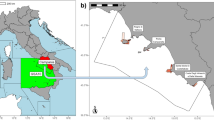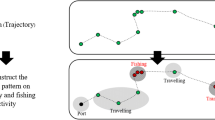Abstract
The ship tracking and mapping capabilities that geospatial technology provides create an opportunity to observe fishing vessels as they move through established maritime boundaries. This paper connects data availability to ground-truthing research and explores the limits of vessel movement mapping in representing worker abuse at sea through three related themes. First, a conceptual background links the advancements in maritime remote sensing to critical GIS scholarship and provides a background on worker abuse aboard Taiwanese fishing vessels. Second, the paper examines the potential of machine learning algorithms to represent worker abuse at sea, arguing that more extensive ground-truthing research with workers could help address variations in the data and limited data sets. Third, I use remote sensing data to identify and unpack Taiwanese fishing across the three EEZs with the most concentrated Taiwanese fishing activity: starting with Taiwan, followed by the Falkland Islands, and Seychelles. I argue that fishing activity and the digital representation of vessel movements are governed by terrestrial geopolitics and subject to manipulation by ship captains. Finally, the conclusion offers recommendations for how future research can capitalize on the capabilities of AIS, particularly with respect to addressing problems of working conditions and abuse at sea.







Similar content being viewed by others
References
Alberts, E. 2022. Seychelles adopts transparency in fisheries, but gaps in data and action remain. https://www.ecobusiness.com/news/seychelles-adopts-transparency-in-fisheries-but-gaps-in-data-and-action-remain/. Accessed 2 Feb 2023.
Angwin, J., J. Larson, S. Mattu, and L. Kirchner. 2022. Machine bias. In Ethics of data and analytics, 254–264. Auerbach Publications.
Arkhipkin, A., Barton, J., Wallace, S., and A. Winter. 2013. Close cooperation between science, management and industry benefits sustainable exploitation of the Falkland Islands squid fisheriesa. Journal of Fish Biology 83(4):905–920. Carmine, G., Mayorga, J., Miller, N. A., Park.
Blanchard, B. 2023. Taiwan Strait is an international waterway, Taipei says, in rebuff to China. Reuters. https://www.reuters.com/world/asia-pacific/taiwan-strait-is-an-international-waterway-taipei-says-rebuffchina-2022-06-14/. Accessed 3 Nov 2023.
Blomley, N. 2019. The territorialization of property in land: Space, power and practice. Territory, Politics, Governance 7 (2): 233–249.
Carpenter, J. 2015. Google’s algorithm shows prestigious job ads to men, but not to women. The Independent. www.independent.co.uk/life-style/gadgetsand-tech/news/googles-algorithm-shows-prestigious-jobads-to-menbut-not-to-women-10372166.html. Accessed 2 Feb 2021.
Dunn, D.C., Jablonicky, C., Crespo, G.O., McCauley, D.J., Kroodsma, D.A., Boerder, K., ... and P.N. Halpin 2018. Empowering high seas governance with satellite vessel tracking data. Fish and Fisheries 19(4):729–739.
Elwood, S. 2008. Volunteered geographic information: future research directions motivated by critical, participatory, and feminist GIS. GeoJournal 72 (3-4): 173–183.
Farthing, C. 2021. Satellite technology can offer cost-effective solutions to ocean governance, but stakeholders must work together to be successful. https://globalfishingwatch.org/fisheries/a-call-for-collaboration-to-tackle-forced-labor-in-fishing/.
Ferrà, C., A.N. Tassetti, E.N. Armelloni, A. Galdelli, G. Scarcella, and G. Fabi. 2020. Using AIS to attempt a quantitative evaluation of unobserved trawling activity in the Mediterranean Sea. Frontiers in Marine Science 7: 1036.
Global Fishing Watch. 2020. Illuminating global fishing activity with satellite AIS. https://globalfishingwatch.org/data/spire/. Accesses 15 Feb 2022.
Global Fishing Watch. 2022. The global fishing watch map. https://globalfishingwatch.org/our-map/. Accessed 8 Jan 2022.
Greenpeace. 2020. Choppy waters: Forced labour and illegal fishing in Taiwan’s distant water. Fisheries. https://www.greenpeace.org/usa/wp-content/uploads/2020/03/b87c6229-2020-choppy-waters-en.pdf. Accessed 2 Feb 2021.
Haklay, M. 2013. Neogeography and the delusion of democratisation. Environment and Planning A 45 (1): 55–69.
Harte, M., and J. Barton. 2007. Balancing local ownership with foreign investment in a small island fishery. Ocean & Coastal Management 50 (7): 523–537.
Hawkins, D.M. 2004. The problem of overfitting. Journal of Chemical Information and Computer Sciences 44 (1): 1–12.
International Labour Office. 2013. Caught at sea: Forced labour and trafficking in the fisheries. https://www.ilo.org/wcmsp5/groups/public/%2D%2D-ed_norm/%2D%2D-declaration/documents/publication/wcms_214472.pdf. Accessed 8 Feb 2021.
International Maritime Organization. 2015. Revised guidelines for the onboard operational use of shipborne automatic identification systems (AIS). https://wwwcdn.imo.org/localresources/en/OurWork/Safety/Documents/AIS/Resolution%20A.1106(29).pdf. Accessed 08 Feb 2021.
Jaton, F. 2021. Assessing biases, relaxing moralism: On ground-truthing practices in machine learning design and application. Big Data & Society 8 (1): 20539517211013570.
Joo, R., O. Salcedo, M. Gutierrez, R. Fablet, and S. Bertrand. 2015. Defining fishing spatial strategies from VMS data: Insights from the world’s largest monospecific fishery. Fisheries Research 164: 223–230.
Kang, E.B. 2023. Ground truth tracings (GTT): On the epistemic limits of machine learning. Big Data & Society 10 (1): 20539517221146120.
Kroodsma, D.A., T. Hochberg, P.B. Davis, F.S. Paolo, R. Joo, and B.A. Wong. 2022. Revealing the global longline fleet with satellite radar. Scientific Reports 12 (1): 21004.
Lake, D.A. 1993. Leadership, hegemony, and the international economy: Naked emperor or tattered monarch with potential? International Studies Quarterly 37 (4): 459–489.
Law, J. 1984. On the methods of long-distance control: Vessels, navigation and the Portuguese route to India. The Sociological Review 32 (1_suppl): 234–263.
Lee, S. 2022. Towards instability: The shifting nuclear-conventional dynamics in the Taiwan Strait. Journal for Peace and Nuclear Disarmament 5 (sup1): 154–166.
Lehman, J. 2016. A sea of potential: The politics of global ocean observations. Political Geography 55: 113–123.
Lozano, A.J.G., Sparks, J.L.D., Durgana, D.P., Farthing, C.M., Fitzpatrick, J., Krough-Poulsen, B., ... and J.N.Kittinger. 2022. Decent work in fisheries: Current trends and key considerations for future research and policy. Marine Policy 136:104922.
Maritime Executive. 2015. Falkland Islands moves to protect fishermen. https://www.maritime-executive.com/article/falklandislands-moves-to-protect-fishermen. Accessed 15 Feb 2022.
Marschke, M., M. Andrachuk, P. Vandergeest, and C. McGovern. 2020. Assessing the role of information and communication technologies in responding to ‘slavery scandals’. Maritime Studies 19: 419–428.
McDonald, G.G., C. Costello, J. Bone, R.B. Cabral, V. Farabee, T. Hochberg, D. Kroodsma, T. Mangin, K.C. Meng, and O. Zahn. 2021. Satellites can reveal global extent of forced labor in the world’s fishing fleet. Proceedings of the National Academy of Sciences 118 (3): e2016238117.
Miller, D. D., Sumaila, U. R., Copeland, D., Zeller, D., Soyer, B., Nikaki, T., ... and D. Pauly. 2016. Cutting a lifeline to maritime crime: Marine insurance and IUU fishing. Frontiers in Ecology and the Environment 14(7):357–362.
Mullins, U. 2007. Leveraging technology to improve VTS operations. Proceedings of the Marine Safety & Security Council 64 (2): 16–17.
Noble, S.U. 2018. Algorithms of oppression: How search engines reinforce racism. New York University Press.
Obermeyer, Z., B. Powers, C. Vogeli, and S. Mullainathan. 2019. Dissecting racial bias in an algorithm used to manage the health of populations. Science 366 (6464): 447–453.
Oceana. 2021. Now you see me, now you don’t: vanishing vessels along Argentina’s waters. https://usa.oceana.org/wp-content/uploads/sites/4/2021/06/oceana_argentina_mini_report_finalupdated.pdf. Accessed 8 Feb 2022.
ORBCOMM. 2016. AIS: The largest maritime paradigm shift in over a century. https://blog.orbcomm.com/satellite-ais-the-largest-maritime-paradigm-shift-in-over-a-century/. Accessed 8 Feb 2021.
O’Sullivan, D. 2006. Geographical information science: Critical GIS. Progress in Human Geography 30 (6): 783–791.
Pavlovskaya, M. 2018. Critical GIS as a tool for social transformation. The Canadian Geographer/Le Géographe Canadien 62 (1): 40–54.
Pezzani, L., and C. Heller. 2019. AIS politics: The contested use of vessel tracking at the EU’s maritime frontier. Science, Technology, & Human Values 44 (5): 881–899.
Pickles, J., ed. 1995. Ground truth: The social implications of geographic information systems. Guilford Press.
Sack, Robert. 1986. Human territoriality: Its theory and history. Cambridge: Cambridge University Press.
Scott, J.C. 1998. Seeing like a state: How certain schemes to improve the human condition have failed. New Haven CT: Yale University Press
Sharpe, C.E. 2016. In the wake: On blackness and being. Durham: Duke University Press.Simmons, G., & Stringer, C. (2014). New Zealand’s fisheries management system: Forced labour an ignored or overlooked dimension?. Marine Policy 50:74–80.
Sheppard, E. 2005. Knowledge production through critical GIS: Genealogy and prospects. Cartographica: The International Journal for Geographic Information and Geovisualization 40(4):5–21.
Shih, Y.C., Y.C. Chang, W. Gullett, and W.Y. Chiau. 2020. Challenges and opportunities for fishery rights negotiations in disputed waters–a Taiwanese perspective regarding a fishing boat case incident. Marine Policy 121: 103755.
Silveira, P.A.M., A.P. Teixeira, and C.G. Soares. 2013. Use of AIS data to characterise marine traffic patterns and ship collision risk off the coast of Portugal. The Journal of Navigation 66 (6): 879–898.
Swartz, W., A.M. Cisneros-Montemayor, G.G. Singh, P. Boutet, and Y. Ota. 2021. AIS-based profiling of fishing vessels falls short as a “proof of concept” for identifying forced labor at sea. Proceedings of the National Academy of Sciences 118 (19): e2100341118. https://doi.org/10.1073/pnas.2100341118.
Thomas, G. 2003. A maritime traffic-tracking system cornerstone of maritime homeland defense. Naval War College Review 56 (4): 137–152.
Tu, E., G. Zhang, L. Rachmawati, E. Rajabally, and G.B. Huang. 2017. Exploiting AIS data for intelligent maritime navigation: A comprehensive survey from data to methodology. IEEE Transactions on Intelligent Transportation Systems 19 (5): 1559–1582.
Vandergeest, P., and N.L. Peluso. 1995. Territorialization and state power in Thailand. Theory and Society: 385–426.
Vandergeest, P., and M. Marschke. 2021. Beyond slavery scandals: Explaining working conditions among fish workers in Taiwan and Thailand. Marine Policy 132: 104685.
Vyawahare, M. 2021. Red flag: Predatory European ships help push Indian Ocean tuna to the brink. https://news.mongabay.com/2021/04/red-flag-predatory-european-ships-help-push-indian-ocean-tuna-to-the-brink/. Accessed 15 Feb 2022.
Yan, Z., Xiao, Y., Cheng, L., He, R., Ruan, X., Zhou, X., ... and R. Bin. 2020. Exploring AIS data for intelligent maritime routes extraction. Applied Ocean Research 101:102271.
Funding
This study was supported by the Social Sciences and Humanities Research Council (SSHRC) of Canada, grant number 435–2020-1304.
Author information
Authors and Affiliations
Corresponding author
Ethics declarations
Conflict of interest
The authors declare no competing interests.
Additional information
Publisher's Note
Springer Nature remains neutral with regard to jurisdictional claims in published maps and institutional affiliations.
Rights and permissions
Springer Nature or its licensor (e.g. a society or other partner) holds exclusive rights to this article under a publishing agreement with the author(s) or other rightsholder(s); author self-archiving of the accepted manuscript version of this article is solely governed by the terms of such publishing agreement and applicable law.
About this article
Cite this article
Rudolph, T.A. Seeing like an algorithm: the limits of using remote sensing to link vessel movements with worker abuse at sea. Maritime Studies 23, 13 (2024). https://doi.org/10.1007/s40152-024-00351-7
Received:
Accepted:
Published:
DOI: https://doi.org/10.1007/s40152-024-00351-7




